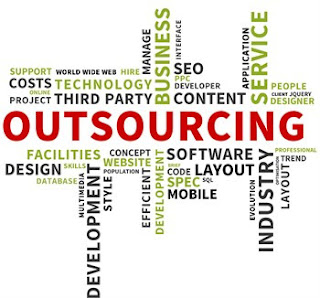19.1 Describe the advantages and disadvantages of insourcing ,outsourcing ,and offshore outsourcing.
19.2 Describe why outsourcing is a critical business decision.
1.Outsourcing Projects
➜Insourcing -common approach using professional expertise within an organization to develop and maintain the organization's information technology systems.
➜Outsourcing -an arrangement by which one organization provides service or services for another organization that chooses not to perform them in-house.They hired outside people because did not have expertise and focus on core competency.
*The most common functions outsource is information technology.
*Reasons companies outsource
➔Onshore outsourcing -engaging another company within the same country for services.
➔Nearshore outsourcing -Contracting an outsourcing arrangement with a company in a nearby country such as Singapore,Indonesia ,Thailand,Brunei.
➔Offshore outsourcing -using organizations from developing countries to write code and develop systems .For example ,United Kingdom and United States will invest in Malaysia.
*Big selling point for offshore outsourcing "inexpensive good work"
➤Factors driving outsourcing growth include :
➥Core competencies - To fuel revenue growth rather than just a cost-cutting measure.
➥Financial savings -Cheaper to hire workers in China and India than workers in United States (offshore outsource).
➥Rapid growth -Able to acquire best-practices process expertise .This facilitates the design,building,training,and deployment of business processes or functions.
➥Industry changes - Increased demand for outsourcing to better focus on core competencies.
➥The Internet -Effective sales channel has allowed clients to become more comfortable with outsourcing.
➥Globalization -Engage outsourcing service providers to deliver international services.
*Most organizations outsource their noncore business functions such as payroll and IT.
2.Outsourcing benefits include:
➜Increased quality and efficiency.
➜Reduced operating expenses.
➜Outsourcing non-core processes.
➜Increased flexibility.
➜Access to advanced technologies.
3.Outsourcing challenges include :
➤Contract length
*Most outsourcing contracts span several years and cause the issues discussed above.
➥Difficulties in getting out of a contract.
➥Problems in foreseeing future needs.
➥Problems in reforming an internal IT department after the contract is finished.
➤Competitive edge
➥Effective and innovative use of IT can be lost when using an outsourcing service provider.
➤Confidentiality
➥Confidential information might be breached by an outsourcing service provider especially one that provides services to competitors.
➤Scope definition
➥Scope creep is a common problem with outsourcing agreements (have to pay more if we ask to do more).

















































